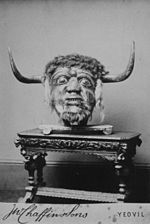- Dorset Ooser
-
The Dorset Ooser is the name of a horned mask that has been a part of folklore in the town of Dorchester, in the county of Dorset in southern England, for several centuries. The original mask disappeared in 1897, though a modern replica, made in 1975 by John Byfleet, is held in Dorchester County Museum, where it is taken out as a part of a procession of Morris dancers atop the Cerne Abbas giant on May Day and St George's Day,[1] though some records indicate that in the 19th century it was paraded at Christmas instead.[2]
Both the mask and the modern replica have a hinged jaw, allowing it to move, in much the same way that hobby horses, another folkloric English tradition, move their jaws.
History
It is unknown when the original mask was made, but appeared to be in a tradition of making animal and grotesque masks to be worn in procession; in the 7th century book Liber Poenitentialis by the then Archbishop of Canterbury, Theodore, he stated "whoever at the kalends of January goes about as a stag or bull; that is, making himself into a wild animal and dressing in the skin of a herd animal, and putting on the heads of beast, those who in such wise transform themselves into the appearance of a wild animal, penance for three years because this is devilish".[2]
The mask became the property of the Cave family of Holt Farm, Melbury Osmond, in Dorest, who remarked that it was used in local revels by a man dressed in animal skins.[2] It was first mentioned in print in the 1891 book Somerset and Dorset Notes and Queries.[2]
In the late 19th century, Dr Edward Cave, who owned the mask, moved to Crewkerne, and he took the mask with him. He later moved to Bath, but left the object in Crewkerne, where it was under the charge of a family coachman. The head disappeared, and the coachman claimed that he had sold it to a stranger from "up Chinnock way".[2] Its whereabouts are currently unknown.
One of the main theories regarding the usage of the Ooser is that it was a representation of the Devil, though another theory, purported by Margaret Murray, in her 1933 book The God of the Witches, and her supporters, such as Doreen Valiente,[2] but now largely discredited,[citation needed] claims that it actually depicts the Horned God, a deity worshipped by a supposed underground Witchcraft cult which was the basis for modern Wicca. An illustration of the Ooser is held at the Museum of Witchcraft in the nearby county of Cornwall.
The Gardnerian initiate, and researcher into the history of Wicca, Melissa Seims, believed that the statue of the Horned God Atho which was built by Raymond Howard may have been based upon the iconography of the Dorset Ooser.[3]
References
- ^ http://www.spiritsofnature.co.uk/wessex/abt_wesx.html#section3
- ^ a b c d e f Valiente, Doreen (1973). An ABC of Witchcraft Past and Present. Hale. p. 95 to 96.
- ^ Seims, Melissa, The Coven of Atho in The Cauldron no.126, November 2007 - http://www.thewica.co.uk/coven_of_atho%20article.htm
External links
Categories:- Horned deities
- Masks
- Ritual animal disguise
- Dorset folklore
Wikimedia Foundation. 2010.

